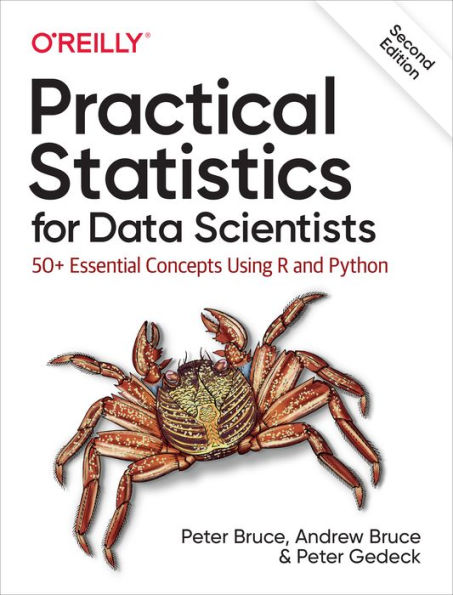Table of Contents
Preface xiii
1 Exploratory Data Analysis 1
Elements of Structured Data 2
Further Reading 4
Rectangular Data 4
Data Frames and Indexes 6
Nonrectangular Data Structures 6
Further Reading 7
Estimates of Location 7
Mean 9
Median and Robust Estimates 10
Example: Location Estimates of Population and Murder Rates 12
Further Reading 13
Estimates of Variability 13
Standard Deviation and Related Estimates 14
Estimates Based on Percentiles 16
Example: Variability Estimates of State Population 18
Further Reading 19
Exploring the Data Distribution 19
Percentiles and Boxplots 20
Frequency Tables and Histograms 22
Density Plots and Estimates 24
Further Reading 26
Exploring Binary and Categorical Data 27
Mode 29
Expected Value 29
Probability 30
Further Reading 30
Correlation 30
Scatterplots 34
Further Reading 36
Exploring Two or More Variables 36
Hexagonal Binning and Contours (Plotting Numeric Versus Numeric Data) 36
Two Categorical Variables 39
Categorical and Numeric Data 41
Visualizing Multiple Variables 43
Further Reading 46
Summary 46
2 Data and Sampling Distributions 47
Random Sampling and Sample Bias 48
Bias 50
Random Selection 51
Size Versus Quality: When Does Size Matter? 52
Sample Mean Versus Population Mean 53
Further Reading 53
Selection Bias 54
Regression to the Mean 55
Further Reading 57
Sampling Distribution of a Statistic 57
Central Limit Theorem 60
Standard Error 60
Further Reading 61
The Bootstrap 61
Resampling Versus Bootstrapping 65
Further Reading 65
Confidence Intervals 65
Further Reading 68
Normal Distribution 69
Standard Normal and QQ-Plots 71
Long-Tailed Distributions 73
Further Reading 75
Student's t-Distribution 75
Further Reading 78
Binomial Distribution 78
Further Reading 80
Chi-Square Distribution 80
Further Reading 81
F-Distribution 82
Further Reading 82
Poisson and Related Distributions 82
Poisson Distributions 83
Exponential Distribution 84
Estimating the Failure Rate 84
Weibull Distribution 85
Further Reading 86
Summary 86
3 Statistical Experiments and Significance Testing 87
A/B Testing 88
Why Have a Control Group? 90
Why lust A/B? Why Not C, D,…? 91
Further Reading 92
Hypothesis Tests 93
The Null Hypothesis 94
Alternative Hypothesis 95
One-Way Versus Two-Way Hypothesis Tests 95
Further Reading 96
Resampling 96
Permutation Test 97
Example: Web Stickiness 98
Exhaustive and Bootstrap Permutation Tests 102
Permutation Tests: The Bottom Line for Data Science 102
Further Reading 103
Statistical Significance and p-Values 103
p-Value 106
Alpha 107
Type 1 and Type 2 Errors 109
Data Science and p-Values 109
Further Reading 110
t-Tests 110
Further Reading 112
Multiple Testing 112
Further Reading 116
Degrees of Freedom 116
Further Reading 118
ANOVA 118
F-Statistic 121
Two-Way ANOVA 123
Further Reading 124
Chi-Square Test 124
Chi-Square Test: A Resampling Approach 124
Chi-Square Test: Statistical Theory 127
Fisher's Exact Test 128
Relevance for Data Science 130
Further Reading 131
Multi-Arm Bandit Algorithm 131
Further Reading 134
Power and Sample Size 135
Sample Size 135
Further Reading 138
Summary 139
4 Regression and Prediction 141
Simple Linear Regression 141
The Regression Equation 143
Fitted Values and Residuals 145
Least Squares 148
Prediction Versus Explanation (Profiling) 149
Further Reading 150
Multiple Linear Regression 150
Example: King County Housing Data 151
Assessing the Model 153
Cross-Validation 155
Model Selection and Stepwise Regression 156
Weighted Regression 159
Further Reading 161
Prediction Using Regression 161
The Dangers of Extrapolation 161
Confidence and Prediction Intervals 161
Factor Variables in Regression 163
Dummy Variables Representation 164
Factor Variables with Many Levels 167
Ordered Factor Variables 169
Interpreting the Regression Equation 169
Correlated Predictors 170
Multicollinearity 172
Confounding Variables 172
Interactions and Main Effects 174
Regression Diagnostics 176
Outliers 177
Influential Values 179
Heteroskedasticity, Non-Normality, and Correlated Errors 182
Partial Residual Plots and Nonlinearity 185
Polynomial and Spline Regression 187
Polynomial 188
Splines 189
Generalized Additive Models 192
Further Reading 193
Summary 194
5 Classification 195
Naive Bayes 196
Why Exact Bayesian Classification Is Impractical 197
The Naive Solution 198
Numeric Predictor Variables 200
Further Reading 201
Discriminant Analysis 201
Covariance Matrix 202
Fisher's Linear Discriminant 203
A Simple Example 204
Further Reading 207
Logistic Regression 208
Logistic Response Function and Logit 208
Logistic Regression and the GLM 210
Generalized Linear Models 212
Predicted Values from Logistic Regression 212
Interpreting the Coefficients and Odds Ratios 213
Linear and Logistic Regression: Similarities and Differences 214
Assessing the Model 216
Further Reading 219
Evaluating Classification Models 219
Confusion Matrix 221
The Rare Class Problem 223
Precision, Recall, and Specificity 223
ROC Curve 224
AUC 226
Lift 228
Further Reading 229
Strategies for Imbalanced Data 230
Undersampling 231
Oversampling and Up/Down Weighting 232
Data Generation 233
Cost-Based Classification 234
Exploring the Predictions 234
Further Reading 236
Summary 236
6 Statistical Machine Learning 237
K-Nearest Neighbors 238
A Small Example: Predicting Loan Default 239
Distance Metrics 241
One Hot Encoder 242
Standardization (Normalization, z-Scores) 243
Choosing K 246
KNN as a Feature Engine 247
Tree Models 249
A Simple Example 250
The Recursive Partitioning Algorithm 252
Measuring Homogeneity or Impurity 254
Stopping the Tree from Growing 256
Predicting a Continuous Value 257
How Trees Are Used 258
Further Reading 259
Bagging and the Random Forest 259
Bagging 260
Random Forest 261
Variable Importance 265
Hyperparameters 269
Boosting 270
The Boosting Algorithm 271
XGBoost 272
Regularization: Avoiding Overfitting 274
Hyperparameters and Cross-Validation 279
Summary 282
7 Unsupervised Learning 283
Principal Components Analysis 284
A Simple Example 285
Computing the Principal Components 288
Interpreting Principal Components 289
Correspondence Analysis 292
Further Reading 294
K-Means Clustering 294
A Simple Example 295
K-Means Algorithm 298
Interpreting the Clusters 299
Selecting the Number of Clusters 302
Hierarchical Clustering 304
A Simple Example 305
The Dendrogram 306
The Agglomerative Algorithm 308
Measures of Dissimilarity 309
Model-Based Clustering 311
Multivariate Normal Distribution 311
Mixtures of Normals 312
Selecting the Number of Clusters 315
Further Reading 318
Scaling and Categorical Variables 318
Scaling the Variables 319
Dominant Variables 321
Categorical Data and Gower's Distance 322
Problems with Clustering Mixed Data 325
Summary 326
Bibliography 327
Index 329



